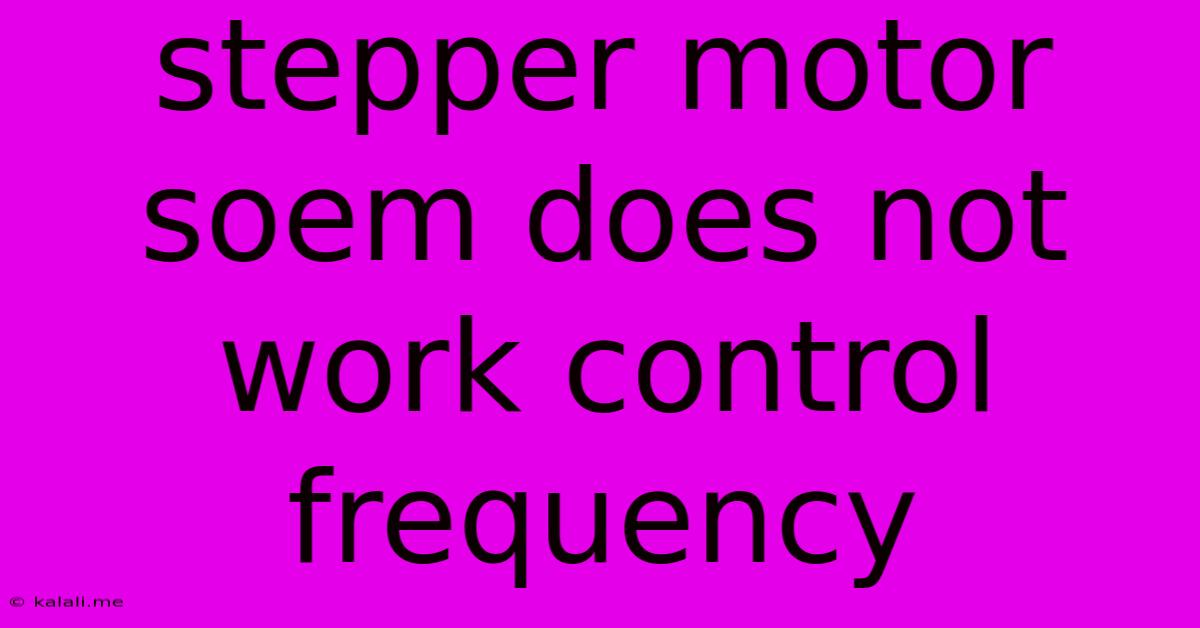Stepper Motor Soem Does Not Work Control Frequency
Kalali
May 23, 2025 · 3 min read

Table of Contents
Stepper Motor SOEM Doesn't Work: Troubleshooting Control Frequency Issues
This article tackles a common problem encountered when controlling stepper motors using the Open Source EtherCAT Master (SOEM): failure to achieve the desired control frequency. This can manifest as jerky movement, missed steps, or complete motor inactivity, despite seemingly correct configuration. We will explore the most common causes and provide troubleshooting strategies. This guide assumes a basic understanding of stepper motors, EtherCAT, and SOEM.
Stepper motors offer precise control, but their operation with SOEM can be nuanced. Achieving the desired control frequency is crucial for smooth and accurate movement. If your SOEM-controlled stepper motor isn't performing as expected, the problem likely lies in one of several areas.
1. Hardware Considerations: Check Your Connections and Components
Before diving into software issues, ensure your hardware is correctly configured:
- Power Supply: Is the stepper motor receiving sufficient and stable power? Insufficient power can lead to erratic behavior and missed steps, regardless of the control frequency. Verify voltage and amperage ratings match the motor's specifications. Check for loose connections and voltage drops.
- Wiring: Carefully inspect all wiring between the stepper motor, the EtherCAT slave, and the PC. Loose connections or short circuits can disrupt communication and prevent proper control. Double-check pin assignments to ensure correct signal routing.
- EtherCAT Slave: Confirm the EtherCAT slave is functioning correctly and properly recognized by SOEM. Test the slave independently if possible, using a separate EtherCAT master to eliminate the SOEM as a potential source of the problem.
- Stepper Motor Driver: Is the driver compatible with both your motor and SOEM’s communication protocol? Ensure it's properly configured and receiving the correct control signals. Driver overheating can also cause malfunction; check its temperature.
2. Software Configuration and SOEM Settings: Pinpointing the Control Loop
Now let's turn to the software side of the equation:
- SOEM Configuration: Review your SOEM configuration file. Are the correct EtherCAT slave addresses and parameters configured? Incorrect settings will prevent the master from communicating effectively with the stepper motor driver. Verify the correct PDO mapping for the control signals (e.g., speed, position).
- Control Frequency Settings: The control frequency within your SOEM code needs to be appropriately set. Too low a frequency will result in jerky motion, while excessively high frequency may exceed the driver’s capabilities. Experiment with adjusting this value to find the optimal setting. Ensure your application's loop rate allows for sufficient processing time between commands.
- Timing and Synchronization: Accurate timing is crucial for real-time control. Ensure the SOEM master is synchronized properly with the EtherCAT network clock. Timing jitter in the control loop can lead to inconsistent behavior. Consider using high-resolution timers to achieve precise control.
- Code Logic and Algorithm: Examine your code to rule out issues with the control algorithm itself. Are you using the correct commands to set the desired speed or position? Are there any race conditions or other potential bugs affecting the real-time control? Step through your code with a debugger to identify any potential issues.
3. Troubleshooting Techniques: A Systematic Approach
- Start Simple: Try controlling the stepper motor at a very low frequency first. If it works at low frequency, gradually increase it, watching for signs of instability.
- Isolate Problems: If you have multiple motors or axes, try controlling them individually to isolate the problem. This will help you pinpoint whether the problem is motor-specific, driver-related, or a general SOEM issue.
- Check for Error Messages: Look for error messages or warnings from SOEM. These messages can provide valuable clues about the cause of the problem. Refer to SOEM documentation for detailed explanations.
- Monitor Signals: Use an oscilloscope or logic analyzer to monitor the control signals going to the stepper motor driver. This will help you verify whether the signals are correct and consistent.
By systematically checking the hardware and software aspects of your setup, and employing a methodical troubleshooting approach, you can pinpoint the source of the frequency control problem and resolve the issue, allowing you to achieve smooth and accurate stepper motor control with your SOEM system. Remember to consult SOEM's documentation and related forums for additional support and troubleshooting tips.
Latest Posts
Latest Posts
-
How To Add Oil To Ac Compressor Without Vacuum
May 23, 2025
-
Tranport To Random Location Spell 5 E
May 23, 2025
-
How To Paint A Rusty Car Roof
May 23, 2025
-
What Do The Kids In Willy Wonka Represent
May 23, 2025
-
Iterm Open New Tab In Same Directory
May 23, 2025
Related Post
Thank you for visiting our website which covers about Stepper Motor Soem Does Not Work Control Frequency . We hope the information provided has been useful to you. Feel free to contact us if you have any questions or need further assistance. See you next time and don't miss to bookmark.